|
This species has been introduced into California. It is not a native species.
|
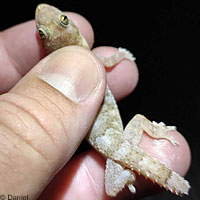 |
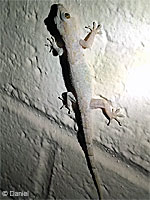 |
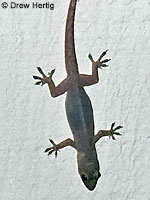 |
Adult, San Diego County
© Daniel |
Adult, San Diego County
© Daniel
Click this link to watch a YouTube video
of this gecko filmed at night in La Mesa.
|
Adult, San Diego County
© Drew Hertig
|
| |
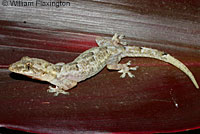 |
|
| |
Adult, Orange County
© William Flaxington |
|
| |
|
|
| Tropical House Geckos from Outside California |
 |
| Adult, Big Pine Key, Monroe County, Florida |
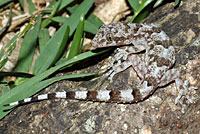 |
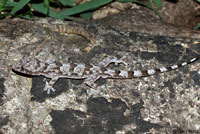 |
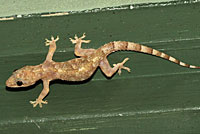 |
Adult, Everglades National Park,
Miami-Dade County, Florida |
Adult, Everglades National Park,
Miami-Dade County, Florida |
Adult, Everglades National Park,
Miami-Dade County, Florida |
| |
|
|
| |
|
|
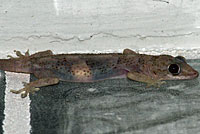 |
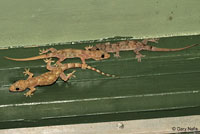 |
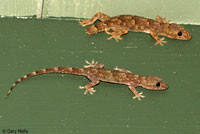 |
Adult, Everglades National Park,
Miami-Dade County, Florida |
Adults, Everglades National Park,
Miami-Dade County, Florida |
Adults, Everglades National Park,
Miami-Dade County, Florida |
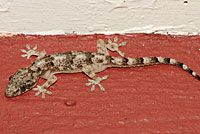 |
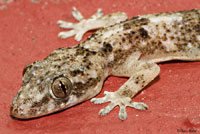 |
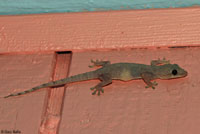 |
Adult, Everglades National Park,
Miami-Dade County, Florida |
Adult, Everglades National Park,
Miami-Dade County, Florida |
Adult, Flamingo,
Monroe County, Florida |
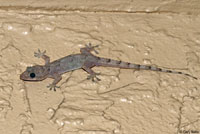 |
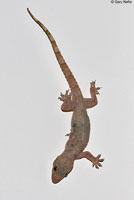 |
|
Adult, Hendry County, Florida
|
Adult, Highlands County, Florida |
|
| |
|
|
| Juveniles |
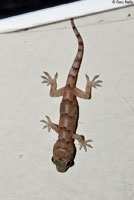 |
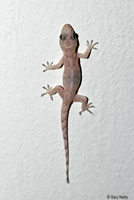 |
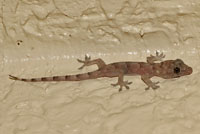 |
Juvenile, Everglades National Park,
Miami-Dade County, Florida |
Juvenile, Everglades National Park,
Miami-Dade County, Florida |
Juvenile, Hendry County, Florida |
| |
|
|
| Description |
| |
| Size |
4-5 inches (10-12.7 cm) in length, snout to vent.
Hatchlings are about 7/8 - 1 inch long, snout to vent (2.2 -2.5 cm).
(Powell, Conant, Collins 2016)
Females tend to be slightly larger than males.
|
| Appearance |
A medium-sized lizard with a slender body, large eyes with vertical pupils, and a flat head that is wider than the neck.
The body is moderately warty, with scattered dorsal tubercles which are not very prominent.
Color is pale, pinkish, gray, or brown, with four or five rear-facing dark chevron-like markings that fade when exposed to light for prolonged periods. When a gecko is in its pale phase there is still a trace of the chevron markings. The chevron markings will distinguish the species from other Hemidactylus geckos found in California. The tail has 10 - 20 dark bars.
The color tends to be darker in the daytime, and lighter at night. When seen on a white wall at night, can appear unmarked and very pale, almost white, in color.
The venter is light in color.
Wide toes are covered with lamellae - spiked scales that help the gecko grip onto vertical surfaces.
Toe pads do not extend the full length of the fourth toe, as they do on H. turcicus.
22-50 pre-anal pores
|
| Life History and Behaviors |
Nocturnal. Takes advantage of artificial light sources to hunt flying insects attracted to the light.
Arboreal - enlarged toe pads make them excellent climbers.
Territorial, aggressive, and fairly sedentary, with a small home range.
Use pheromones to communicate territorial boundaries, to signal dominance, and when a female is ready to mate.
Typically confines its feces to one location, which can make this gecko a household pest.
Average lifespan in the wild or in captivity is 3 - 5 years.
|
| Defense and Predation |
Tropical house geckos can vibrate the tail to distract predators and draw attention to the tail. The tail can be dropped and regenerated. It is common to see geckos with tails that are not original but are in the process or growing back.
More information about tail loss and regeneration.
Body color can be changed from light to dark to better blend into their environment to avoid detection.
Known predators include birds, snakes, and spiders.
In Florida, this gecko is preyed upon by the Cuban Treefrog and the Tokay Gecko. (Meshaka, et al, 2004)
|
| Sound |
Males communicate with other geckos by chirping, most often when they are courting a female. They also produce a low frequency chirp when they are fighting another male.
|
| Diet |
Eats a variety of invertebrates, including spiders, flies, crickets, cockroaches, centipedes, beetles, moths, caterpillars, isopods, and grasshoppers. Also eats hatchlings of other lizard species.
Hunts by sitting and waiting for prey to come close.
Adults tend to be found higher up on buildings where they can feed on flying insects attracted to the electric lights forcing juveniles to feed mostly on the ground where they must feed more on ground-dwelling insects.
|
| Reproduction and Young |
The species includes males and females. Both sexes are mature at one year of age.
Females are oviparous.
Breeding takes place throughout the year.
Females can produce only two eggs at a time, but they can lay up to 7 clutches per year..
Eggs are small, white, calcified, soft, and adhesive, to allow them to be placed in areas other predators can't reach.
Communal nests have been observed with up to 30 eggs. (Meshaka, et al, 2004)
Incubation takes an average of 56 days (22 - 68).
(Animal Diversity Web)
|
| Habitat |
Natural habitat in Africa is varied, including tropical forests, shrub forests, arid and mesic savannah, and coastal bush. Likely to be found in trees and tree hollows, under bark, in rock cracks, and in and on buildings.
Habitats where this gecko has been introduced include sandy areas, scrubby areas near beaches, on tree trunks, and on the inside and outside walls of human structures. Commonly found in urban and suburban areas. The highest population den sites are associated with buildings but is more likely than other introduced geckos to inhabit tree trunks and debris piles far from human structures.
In California, so far found mostly on buildings in urban areas.
|
| Range |
Worldwide Distribution
Native range is sub-Saharan south-central Africa in countries including Angola, Benin, Cameroon, Central African Republic, Chad, Democratic Republic of the Congo (Zaire), Ethiopia, Eritrea, Gabon, Ghana, Guinea (Conakry), Kenya, Madagascar, Mali, Mozambique, Namibia, Nigeria, Senegal, South Africa, Swaziland, Tanzania, Togo, Uganda, Zambia, Zimbabwe, and the islands west of the western Sahara.
First introduced to the Americas transported on ships involved with the slave trade. It has become well-established in much of Florida, the Caribbean, Central America, and South America.
Distribution in California
This species has been reported on citizen science websites (iNaturalist & H.E.R.P.) from San Diego, Orange, and Santa Cruz Counties since 2013. The first published documentation of this species in California that I have found is a March 2021 Geographic Distribution note in Herpetological Review which documents a multi-year persistent population from La Mesa, San Diego County. The species was first discovered there in 2012, and that appears to be the earliest date this species has been documented from California. The colony was already established at that time, so the date of their introduction was probably earlier. The source of the introduction is not known. Surveys found that H. turcicus also occurred at sites with H. mabouia.
(Clark R. Mahrdt, Edward L. Ervin, Gary Nafis. Herpetological Review 52(1), March 2021.)
As of September, 2025, H. mabouia has been reported from several locations in Orange County, including Newport Beach, Santa Ana, Orange, Costa Mesa, Garden Grove, and Tustin, and from several locations in San Diego County including Chula Vista, La Mesa, San Diego, and Rancho Peñasquitos. It has also been observed in Thousand Oaks and Santa Cruz. On the H.E.R.P. database, there are also several records from Orange County and one from San Diego County, with the earliest being from San Diego in 2013.
|
| Taxonomic Notes |
None
|
| Conservation Issues (Conservation Status) |
This species' aggressive and predatory behavior might adversely affect native lizard species and other fauna. In Florida, it has out-competed and replaced the formerly-common Mediterranean Gecko, Hemidactylus turcicus. |
|
|
Taxonomy |
| Family |
Gekkonidae |
Geckos |
Gray, 1825 |
| Genus |
Hemidactylus |
House Geckos |
Gray, 1825 |
Species
|
mabouia |
Tropical House Gecko |
(Moreau de Jonnès, 1818) |
|
Original Description |
Moreau de Jonnès, 1818
|
|
Meaning of the Scientific Name
|
Hemidactylus - Hemidactylus - Greek - hemi = half + Greek - daktylion = fusion of digits
Refers to the split lamella of the fingers and toes in this genus, i.e. the “half” (hemi) lamella under the fingers (Greek 'dactylos')
The name mabouia is derived ‘‘from the language of savage tribes of Septentrional America, and refers to everything that induces disgust or fear’’ (translated from Lacepède, 1788: 379, by A. Miralles, personal communication, 28 November 2006, cited in McCranie 2018: 59).
The Reptile Database
|
|
Alternate Names
|
Wood Slave
Wood Slave Gecko
Woodslave
African House Gecko
Cosmopolitan House Gecko
Moreau's Tropical House Gecko
|
|
Related or Similar California Herps
|
Peninsular Leaf-toed Gecko - Phyllodactylus nocticolus
Non-native geckos in California
Rough-tailed Gecko - Cyrtopodion scabrum
Common House Gecko - Hemidactylus frenatus
Indo-Pacific Gecko - Hemidactylus garnotii
Tropical House Gecko - Hemidactylus mabouia
Flat-tailed House Gecko - Hemidactylus platyurus
Mediterranean Gecko - Hemidactylus turcicus
Yellow Fan-Fingered Gecko - Ptyodactylus hasselquistii
Ringed Wall Gecko - Tarentola annularis
Moorish Gecko - Tarentola mauritanica
|
|
More Information and References
|
Animal Diversity Web
The Reptile Database
Wikipedia
Robert Powell, Roger Conant, and Joseph T. Collins. Peterson Field Guide to Reptiles and Amphibians of Eastern and Central North America. Fourth Edition. Houghton Mifflin Harcourt, 2016.
R. D. Bartlett and Patricia P. Bartlett. A Field Guide to Florida Reptiles and Amphibians. Gulf Publishing Company. 1999
Walter E. Meshaka, Brian P. Butterfield, & J. Brian Hauge. The Exotic Amphibians and Reptiles of Florida. Krieger Publishing Company, Malabar, Florida. 2004.
Bill Branch. Bill Branch's Guide to the Snakes and Other Reptiles of Southern Africa. Ralph Curtis Books, Sanibel Island, Florida. 1988.
|
|
|
The following conservation status listings for this animal are taken from the July 2025 State of California Special Animals List and the July 2025 Federally Listed Endangered and Threatened Animals of California list (unless indicated otherwise below.) Both lists are produced by multiple agencies every year, and sometimes more than once per year, so the conservation status listing information found below might not be from the most recent lists, but they don't change a great deal from year to year.. To make sure you are seeing the most recent listings, go to this California Department of Fish and Wildlife web page where you can search for and download both lists:
https://www.wildlife.ca.gov/Data/CNDDB/Plants-and-Animals.
A detailed explanation of the meaning of the status listing symbols can be found at the beginning of the two lists. For quick reference, I have included them on my Special Status Information page.
If no status is listed here, the animal is not included on either list. This most likely indicates that there are no serious conservation concerns for the animal. To find out more about an animal's status you can also go to the NatureServe and IUCN websites to check their rankings.
Check the current California Department of Fish and Wildlife sport fishing regulations to find out if this animal can be legally pursued and handled or collected with possession of a current fishing license. You can also look at the summary of the sport fishing regulations as they apply only to reptiles and amphibians that has been made for this website.
There are no significant conservation concerns for this non-native lizard in California.
|
| Organization |
Status Listing |
Notes |
| NatureServe Global Ranking |
|
|
| NatureServe State Ranking |
|
|
| U.S. Endangered Species Act (ESA) |
None |
|
| California Endangered Species Act (CESA) |
None |
|
| California Department of Fish and Wildlife |
None |
|
| Bureau of Land Management |
None |
|
| USDA Forest Service |
None |
|
| IUCN |
|
|
|
|
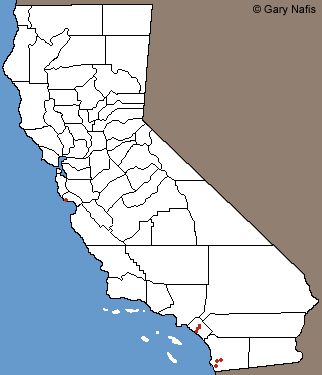 Red: Areas where this non-native species
Red: Areas where this non-native species 



















